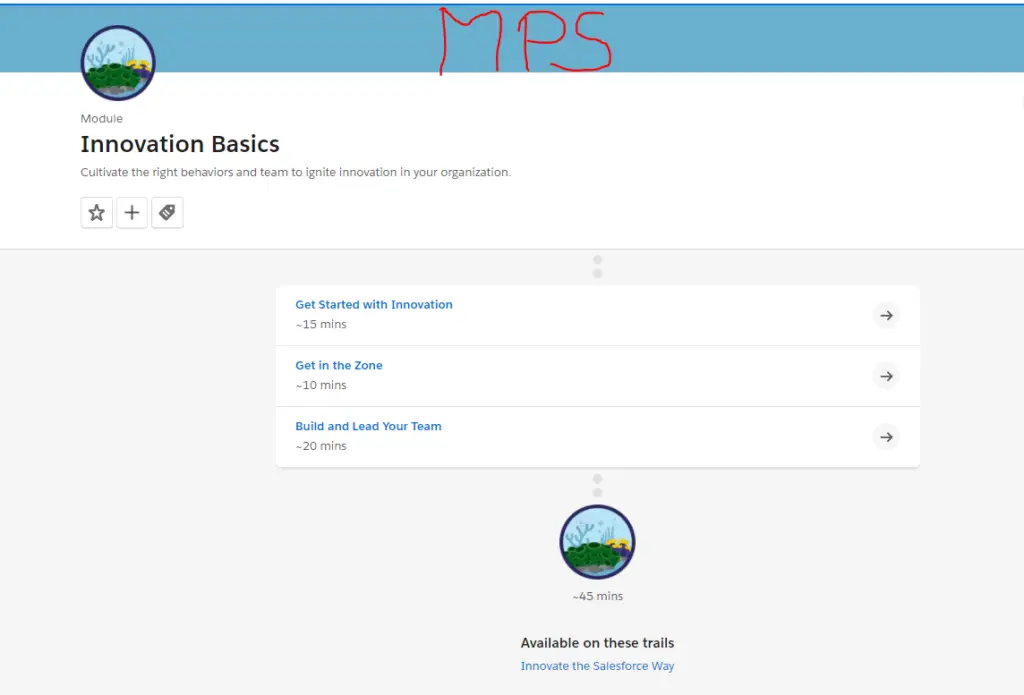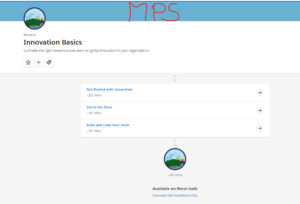In this article, we will basically see what is innovation and its importance, and so on. Innovation is the process of coming up with new ideas and introducing them to the marketplace. The more innovative a company is, the better position it will be in to succeed.
To innovate, a company must first be aware of how innovation occurs in both the general public and specific industries. In order to keep pace with the competition, companies must also invest in new ideas and businesses models.

#1.Get Started with Innovation
Q1)Which descriptions best represent innovation Salesforce Style—the Ohana way?
I)Brave, benevolent, and business-centric
II)Scrappy, solution-focused, and sales-driven
III)Cultural, customer-centric, and continuously innovating
IV)Fast, fun, and frictionless
[bg_collapse view=”button-green” color=”#4a4949″ expand_text=”Show Answers” collapse_text=”Hide Answers” ]
III)Cultural, customer-centric, and continuously innovating
[/bg_collapse]
Q2)Which five phases of innovation does Salesforce recommend to chart the course to customer success?
I)Look, Listen, Learn, Lean, Lift
II)Define, Discover, Dare, Do, Drive
III)Initiate, Investigate, Ideate, Invent, Iterate
IV)Wet, Apply, Scrub, Rinse, Repeat
[bg_collapse view=”button-green” color=”#4a4949″ expand_text=”Show Answers” collapse_text=”Hide Answers” ]
II)Define, Discover, Dare, Do, Drive
[/bg_collapse]
Q3)Which of the following best describes the characteristics of an innovation leader?
I)Would love to invent something new, but is afraid to rock the boat
II)Likes to try technologies once they’ve been tested by others
III)Is overheard at the watercooler saying, “Back in my day…”
IV)Wants to appify their life, loves to challenge the status quo, and dreams of inventing the next big thing
[bg_collapse view=”button-green” color=”#4a4949″ expand_text=”Show Answers” collapse_text=”Hide Answers” ]
IV)Wants to appify their life, loves to challenge the status quo, and dreams of inventing the next big thing
[/bg_collapse]
#2.Get in the Zone
Q1)What is innovation?
I)Anything that delights and amazes customers, making their lives better
II)Anything new and useful—from a product or pricing, to a process or policy, to a business model or an experience
III)Things that change human expectations, attitudes, and behaviors in some way
IV)Creative endeavors inspired by human need
[bg_collapse view=”button-green” color=”#4a4949″ expand_text=”Show Answers” collapse_text=”Hide Answers” ]
II)Anything new and useful—from a product or pricing, to a process or policy, to a business model or an experience
[/bg_collapse]
Q2)Breakthrough innovation is…
I)Less risky than incremental innovation
II)Something that sustains a model
III)A disruptive, paradigm-shifting new approach, product, or service
IV)An improvement to an existing product or service
[bg_collapse view=”button-green” color=”#4a4949″ expand_text=”Show Answers” collapse_text=”Hide Answers” ]
III)A disruptive, paradigm-shifting new approach, product, or service
[/bg_collapse]
Q3)The Doblin Ten Types of Innovation framework describe:
I)The most successful types of product innovation
II)A way to best use the assets in your organization
III)How to structure an innovation project
IV)A framework for categorizing the many types of innovation you can offer your customers
[bg_collapse view=”button-green” color=”#4a4949″ expand_text=”Show Answers” collapse_text=”Hide Answers” ]
IV)A framework for categorizing the many types of innovation you can offer your customers
[/bg_collapse]
#3.Build and Lead Your Team
Q1)Which role is most critical when building your innovation team?
I)The Innovation Ambiance Artist—part DJ, part chef, part comedian
II)The Spiritual Champion—accountable for driving your end-to-end innovation project with passion
III)The Data Geek—poring through years of stats and quantitative analysis
IV)The Postal Worker—because they always deliver
[bg_collapse view=”button-green” color=”#4a4949″ expand_text=”Show Answers” collapse_text=”Hide Answers” ]
II)The Spiritual Champion—accountable for driving your end-to-end innovation project with passion
[/bg_collapse]
Q2)What is the purpose of an executive sponsor?
I)To represent your innovation with analysts, in the press, and on social media
II)To make the big decisions when the team is conflicted
III)To serve as the senior-most champion, driving engagement and adoption of your project
IV)To report on the progress of the effort to the board of directors on a regular basis
[bg_collapse view=”button-green” color=”#4a4949″ expand_text=”Show Answers” collapse_text=”Hide Answers” ]
III)To serve as the senior-most champion, driving engagement and adoption of your project
[/bg_collapse]
Q3)Intrapreneurs drive…
I)Impact within their organization, wielding their entrepreneurial prowess to seed, grow, and advance innovation
II)Innovation through an interconnected ecosystem of customers and partners co-creating solutions
III)Management to wake up to the reality of market opportunities
IV)A rocket ship
[bg_collapse view=”button-green” color=”#4a4949″ expand_text=”Show Answers” collapse_text=”Hide Answers” ]
I)Impact within their organization, wielding their entrepreneurial prowess to seed, grow, and advance innovation
[/bg_collapse]
Q4)Which of these behaviors is a natural part of an innovator’s DNA?
I)Following top executives in the organization in the press to understand their interests and ambitions
II)Making friends easily at conferences and work events
III)Wearing the latest trend in fashion to look the part
IV)Challenging invisible orthodoxies to see beyond the status quo
[bg_collapse view=”button-green” color=”#4a4949″ expand_text=”Show Answers” collapse_text=”Hide Answers” ]
IV)Challenging invisible orthodoxies to see beyond the status quo
[/bg_collapse]
Q5)Failure is a normal part of the innovation process—so how can you avoid sweating it when it happens?
I)Align with management on the intentions and learning goals of your project and celebrate failures as valuable experiences along the way
II)Stay stealthy—don’t tell anyone about your innovation initiative until you are sure all the kinks are worked out
III)Enlist a trusted executive to represent project successes to the leadership team and give your team air cover
IV)Keep goals as ambiguous as possible so you aren’t held accountable while you figure it out
[bg_collapse view=”button-green” color=”#4a4949″ expand_text=”Show Answers” collapse_text=”Hide Answers” ]
I)Align with management on the intentions and learning goals of your project and celebrate failures as valuable experiences along the way
[/bg_collapse]
FAQ
What are the 4 types of innovation?
Innovation is a fundamental part of the business world today. With new developments and breakthroughs happening every day, companies have to continually innovate. But innovation doesn’t always mean creating something entirely new, as there are four different types of innovation that can change the way your company operates: incremental, modular, disruptive, and radical.
Why are inventions so important?
It’s not a secret that inventions are important to the business. The reason is simple – they are the foundation of any company. Without inventions, it’s impossible to produce anything. Anything that’s produced by a company is an invention.
Inventions improve the quality of products and lower the costs of producing them. This makes new inventions extremely valuable for companies and even for consumers.
